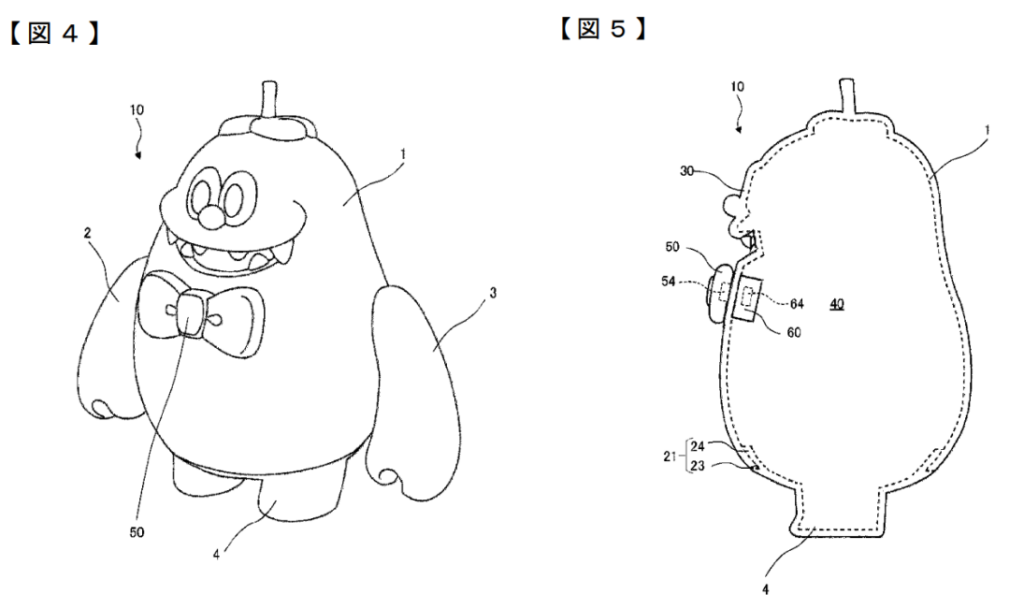
- Overview of the Patent Drawing
- Patent Insight 1: Versatile Decoration Placement for Interactive Play
- Patent Insight 2: Customization Potential with Various Suction-Based Decorations
- Patent Insight 3: Educational Uses for Learning Through Play
- Patent Attorney’s Thoughts
- Keywords
- Application of the Technology: Toyed-Up Smart Home Control Panel
Overview of the Patent Drawing
The illustrations depict a character doll (10) designed to allow a movable decorative part (50) to be attached and repositioned using a suction member, such as a magnet, as an example. Figure 4 shows the character’s external appearance, featuring limbs (2, 3) and a distinctive decorative bow tie (50). In Figure 5, the internal structure reveals an attachment component (64), which represents a type of suction member that could include a magnet. This mechanism allows the decorative part to be securely attached and repositioned on the doll’s surface. The main body (1) accommodates the suction mechanism for flexible decoration placement.
Patent Insight 1: Versatile Decoration Placement for Interactive Play
The use of a suction member, such as a magnet (64), enables flexible positioning of the decorative part (50), like the bow tie. This feature allows users to move the decoration to various locations on the doll, encouraging creative play and customization. Children can enjoy repositioning the decoration, enhancing the doll’s interactive and engaging nature.
Patent Insight 2: Customization Potential with Various Suction-Based Decorations
The design supports the use of multiple decorative parts that can be attached using suction members, such as magnets. This allows for various accessories, including hats, badges, or themed decorations, to be added and repositioned. The ability to customize the doll with different decorations adds to its appeal, especially for children who enjoy personalizing their toys.
Patent Insight 3: Educational Uses for Learning Through Play
The use of suction members, such as magnets, for attaching movable decorative parts can facilitate educational activities, such as teaching spatial awareness, colors, or shapes. It also promotes cognitive development and fine motor skills as children manipulate the movable decorations. The doll could serve as a learning tool in both educational and therapeutic settings.
Patent Attorney’s Thoughts
Looking at the patent drawing for the “Character Doll with Movable Decorative Part Using a Magnet,” I was instantly drawn to its playful elegance.
The idea of using magnets to allow parts of a doll — like wings, accessories, or facial embellishments — to be swapped or reoriented adds a level of interactive fun that feels fresh and inventive.
What really resonates with me is the sense of endless possibility.
Imagine being able to customize your doll on a whim — attach a sparkly accessory, rotate limbs, or change out expressions with a flick — it’s like giving a toy a living, adaptable personality.
That kind of flexibility invites creativity, both for children and collectors.
I also appreciate how the design feels intuitive and clean.
Magnets provide a satisfying click without complexity, making the experience feel almost magical.
It’s a subtle detail, but it turns a simple toy into something more dynamic — something that responds to touch and intention.
Overall, this patent sketch reminds me of the joy of tinkering and personalization.
It’s a thoughtful blend of form and function, and for anyone who loves dolls or hands-on creativity, it promises a new kind of play — one that’s as much about storytelling as it is about design.
Keywords
character doll, suction member, magnet, movable decorative part, customizable toy, interactive play, repositionable decoration, educational toy
Application of the Technology: Toyed-Up Smart Home Control Panel
Purpose
Transform the doll’s magnetically movable parts into an interactive smart-home control “pet”—a whimsical desk companion that lets you manage lights, music, and temperature with cute gestures and pet-like responses.
System Components
- Magnetic Gesture Pet: A small plush or plastic figure with magnetic accessories (like a tail, hat, or wand) that users move to social gestures.
- Magnetic Sensor Grid: Embedded sensors detect the position and movement of magnetic parts for precise gesture recognition.
- Smart Home API Integration: The device connects to smart bulbs, speakers, and thermostats via Wi‑Fi or Bluetooth.
- Mood Response LEDs/Sounds: An LED panel in the pet’s eyes (or accessory) and soft sounds convey intent and affirmation—like wagging for “lights on” or purring for “night mode.”
- Rechargeable Base Station: The pet returns to its “bed” to recharge and sync settings or firmware.
Operational Flow
- Gesture Setup: The user defines actions tied to movements—e.g., flipping the tail up = turn on room light, tipping forward = play music.
- Gesture Execution: Move or spin the magnetic accessory to trigger the chosen action.
- System Response: The pet’s LEDs light up green, it chirps, and the smart bulb turns on or music starts.
- Acknowledgment and Feedback: If successful, the pet nods or emits a cheerful tone. If an error occurs, it shakes its head or displays a red LED.
- Night Mode & Recharge: When no gestures are detected for a set time, the pet gently dims its LEDs and returns to the base station to rest.
This concept transforms a charming magnetic doll into a hands-on, expressive home-automation “pet”—making everyday smart-home actions feel more playful and personable.
Disclaimer: This content is an AI-generated reinterpretation based on a patent drawing.
It is provided for educational and cultural purposes only, and not as legal advice.



